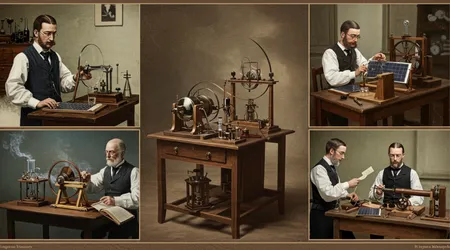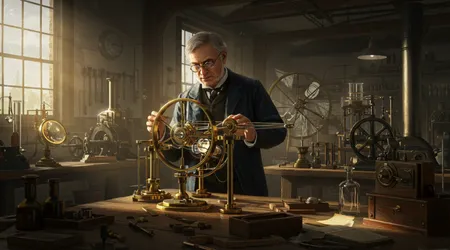The Forgotten History of Solar Power in the 19th Century

The forgotten history of solar power in the 19th century reveals a time when visionary inventors dared to harness the sun’s boundless energy.
Anúncios
Long before solar panels adorned rooftops, pioneers like Augustin Mouchot and Charles Fritts laid the groundwork for a renewable revolution. Their experiments, though often overlooked, were bold steps toward a cleaner future.
This article uncovers their stories, weaving a narrative of ingenuity, ambition, and setbacks that shaped modern solar technology.
Why do we rarely hear about these early trailblazers? Their work, though imperfect, challenges us to rethink how innovation evolves over time. Let’s dive into this captivating chapter of human progress.
Solar power today is a cornerstone of renewable energy, with global capacity reaching 1,133 gigawatts by 2024, according to the International Renewable Energy Agency (IRENA).
Anúncios
Yet, its roots trace back to the 19th century, a period of industrial fervor and scientific curiosity. The era’s inventors didn’t just chase sunlight; they envisioned a world less reliant on coal’s choking grip.
Their creations, from solar engines to early photovoltaic cells, were audacious for their time. This exploration not only honors their legacy but also reframes how we view renewable energy’s long arc.
The Dawn of Solar Innovation
Imagine a world lit by coal smoke, where the sun’s potential was a distant dream. In 1839, French physicist Edmond Becquerel discovered the photovoltaic effect.
His experiments with light-sensitive materials sparked electricity, a breakthrough that would later define solar technology.
This wasn’t just science; it was a glimpse into a new energy paradigm. Becquerel’s work, though theoretical, set the stage for practical applications, igniting curiosity among inventors.
The forgotten history of solar power in the 19th century begins here, with a spark that few noticed.
The industrial age demanded energy, and coal was king. Yet, some dared to look skyward. Becquerel’s discovery wasn’t immediately practical, but it inspired others.
Scientists like Willoughby Smith, in 1873, found selenium’s photoconductive properties, a key step toward solar cells. These early findings were like seeds planted in rocky soil promising but slow to grow.
The era’s focus on fossil fuels overshadowed these efforts, yet they persisted. The forgotten history of solar power in the 19th century is one of quiet persistence against the odds.
++ The Cyclomer: A Bicycle That Could Float on Water
This period wasn’t just about electricity. Inventors explored thermal energy too. Horace-Bénédict de Saussure’s solar oven in 1767, though pre-19th century, influenced later designs.
By the 1800s, his ideas evolved into more ambitious machines. These early experiments weren’t mere curiosities; they were bold bets on the sun’s untapped power.
The forgotten history of solar power in the 19th century shows a blend of science and vision, pushing boundaries despite limited tools.

Augustin Mouchot’s Solar Engines
Augustin Mouchot, a French mathematician, saw the sun as more than a light source. In the 1860s, he built solar-powered steam engines, using mirrors to focus sunlight.
His 1869 concentrator boiled water to drive machinery, a marvel at Paris’ Universal Exposition. Mouchot’s vision wasn’t just technical; it was ecological, warning of coal’s finite limits.
His work is a cornerstone in the forgotten history of solar power in the 19th century, blending innovation with foresight.
Mouchot’s machines weren’t perfect. They were bulky, weather-dependent, and costly compared to coal. Yet, his 1878 solar engine powered a printing press, a practical feat.
In Algeria, he tested larger designs for colonial irrigation, showing solar’s global potential. His assistant, Abel Pifre, later printed 500 copies of Le Journal du Soleil in 1882 using a solar press. This practical example highlights the era’s ambition, despite economic hurdles.
Also read: Why We Stopped Using Zeppelins for Travel
The forgotten history of solar power in the 19th century often omits Mouchot’s struggles. France’s cheap coal imports undermined his funding.
By the 1880s, his projects faded, dismissed as impractical. Yet, his ideas inspired later concentrated solar power (CSP) systems.
Mouchot’s story is a reminder: innovation often outpaces its time, waiting for the world to catch up. His legacy lives in today’s CSP plants, like those in the Mojave Desert.
Charles Fritts and the First Solar Cell
Across the Atlantic, Charles Fritts took a different path. In 1883, this New York inventor created the first solar cell, coating selenium with gold.
With just 1-2% efficiency, it was a far cry from today’s 20% standard. Still, Fritts’ cell proved sunlight could generate electricity without moving parts. This breakthrough marks a pivotal moment in the forgotten history of solar power in the 19th century.
Fritts’ solar cell wasn’t commercially viable. Selenium was costly, and the cells were fragile. Yet, his 1884 rooftop installation in New York was a bold statement.
Imagine a city of gas lamps, with one rooftop quietly converting sunlight into power. His work built on Becquerel’s and Smith’s discoveries, showing the photovoltaic effect’s practical potential.
The forgotten history of solar power in the 19th century owes much to Fritts’ audacity.
Read more: The Great Fireproof Cities Plan That Never Happened
Critics dismissed his cells as inefficient, and coal’s dominance buried his ideas. But Fritts’ vision wasn’t futile. His work laid the foundation for silicon-based cells, developed decades later at Bell Labs.
By 1954, silicon cells reached 6% efficiency, building on Fritts’ legacy. His story is like a lone lighthouse, guiding future innovators through the fog of skepticism.
Other Pioneers and Their Contributions
Beyond Mouchot and Fritts, others shaped solar’s early days. John Ericsson, a Swedish-American inventor, built solar engines in the 1870s, using heat-driven designs.
His machines, though less practical than Mouchot’s, showed diverse approaches to solar power. Ericsson’s focus on thermal energy complemented Fritts’ photovoltaic work, enriching the forgotten history of solar power in the 19th century.
In 1888, Edward Weston patented a solar-powered device, blending thermal and electrical concepts. His work, though obscure, added to the era’s experimental spirit.
Meanwhile, Melvin Severy’s 1894 patents for solar thermopiles allowed panels to track the sun, boosting efficiency.
These inventions, though overshadowed, were critical stepping stones. Each pioneer chipped away at the challenge of harnessing sunlight effectively.
The forgotten history of solar power in the 19th century also includes global efforts. In Egypt, Frank Shuman’s 1913 solar plant (built on 19th-century ideas) irrigated cotton fields.
This practical application showed solar’s potential beyond labs. These diverse experiments, from France to Egypt, reveal a global quest to tame the sun, despite technological and economic barriers.
Why These Innovations Were Forgotten
Why did these breakthroughs fade into obscurity? Coal was cheap, abundant, and reliable, unlike weather-dependent solar. Industrial societies prioritized immediate gains over long-term potential.
Mouchot’s engines and Fritts’ cells were costly and inefficient, making them easy targets for skepticism. The forgotten history of solar power in the 19th century reflects a world not yet ready for renewables.
Cultural and economic inertia played a role. The Industrial Revolution glorified fossil fuels, sidelining alternatives. Governments and investors favored proven technologies, not experimental ones.
Mouchot lost funding; Fritts’ cells were mocked. Yet, their ideas survived in niche applications, like early satellites, proving their worth over time. History often buries pioneers who are ahead of their era.
Consider an analogy: these inventors were like early aviators, building fragile wings before flight was practical. Their failures taught lessons that later generations perfected.
The forgotten history of solar power in the 19th century isn’t just about lost ideas; it’s about resilience. Today’s solar farms owe their existence to these early dreamers, whose work was rediscovered when the world was ready.
The Legacy and Modern Relevance

The forgotten history of solar power in the 19th century isn’t just a historical footnote; it’s a call to action. Today’s solar industry, powering 5% of global electricity, builds on these foundations.
Mouchot’s concentrators inspire modern CSP plants; Fritts’ cells prefigure silicon panels. Their work reminds us that innovation requires patience and vision, even when results aren’t immediate.
In 2025, solar power is no longer a curiosity but a necessity. Climate change demands clean energy, and solar’s scalability makes it a leader.
From rooftop panels to desert arrays, the technology has evolved, but its roots remain in the 19th century. These pioneers showed that big ideas can start small, even in the face of doubt.
Their legacy also challenges us to look forward. What innovations are we dismissing today that might power tomorrow?
The forgotten history of solar power in the 19th century teaches us to value bold ideas, even when they seem impractical.
As we face a warming planet, these stories inspire us to keep pushing for a sustainable future.
Table: Key 19th Century Solar Innovations
| Year | Inventor | Innovation | Impact |
|---|---|---|---|
| 1839 | Edmond Becquerel | Photovoltaic effect discovered | Foundation for solar cell technology |
| 1869 | Augustin Mouchot | Solar concentrator for steam engine | Early practical solar application |
| 1883 | Charles Fritts | First selenium-based solar cell | Proved direct sunlight-to-electricity |
| 1894 | Melvin Severy | Solar thermopile with tracking system | Improved efficiency and practicality |
This exploration of the forgotten history of solar power in the 19th century reveals a story of visionaries who dared to dream beyond their time.
Their work, though initially dismissed, planted seeds that grew into today’s solar revolution.
By honoring their legacy, we’re reminded that today’s bold ideas could shape tomorrow’s world. Let’s keep looking to the sun for inspiration.
Frequently Asked Questions
Q: Why were 19th-century solar inventions overlooked?
A: Cheap coal and industrial priorities overshadowed solar’s high costs and inefficiencies, delaying its adoption until technology and economics aligned.
Q: How did Mouchot’s solar engine work?
A: It used mirrors to focus sunlight, boiling water to create steam that powered machinery, like a printing press in 1882.
Q: Are 19th-century solar ideas still relevant?
A: Yes, modern CSP and photovoltaic systems trace their origins to Mouchot’s concentrators and Fritts’ cells, driving today’s renewable revolution.
